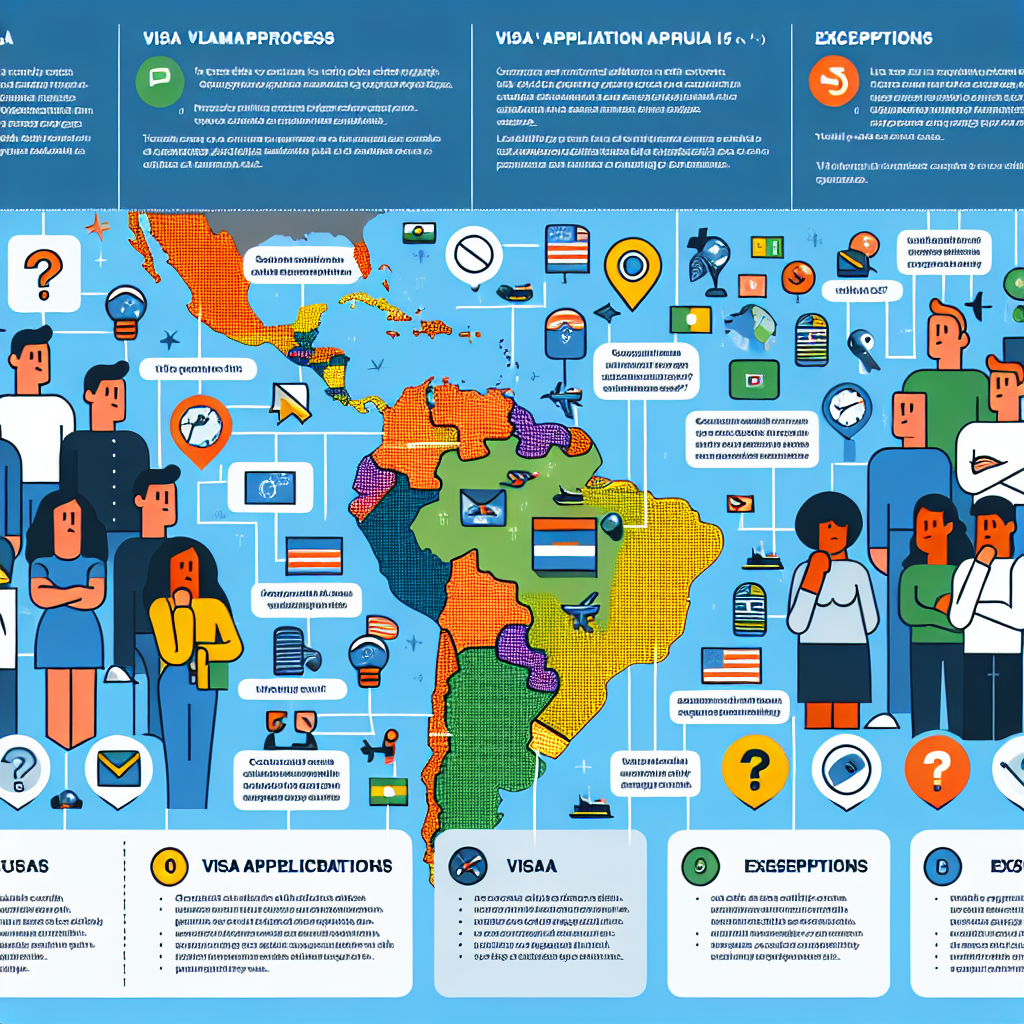
Planning a cruise to explore the vibrant and diverse countries of South America? Before you set sail, it’s essential to understand the visa requirements for your trip. While some South American countries allow cruise passengers to enter without a visa, others require specific travel documents for certain nationalities. Whether you’re visiting the iconic Machu Picchu in Peru or dancing the tango in Buenos Aires, this article will provide you with valuable information on the visa regulations for South American countries, ensuring a hassle-free journey filled with incredible experiences.

Visa Requirements for South American Countries
General Overview of Visa Requirements
When planning a trip to South America, it’s important to familiarize yourself with the visa requirements for each country you plan to visit. While some countries have visa exemptions for certain nationalities, others may require you to obtain a visa in advance. It’s crucial to understand the specific visa regulations to ensure a smooth and hassle-free journey.
Different Visa Requirements for Different Countries
South America is a diverse continent with various visa requirements for different countries. Each nation has its own set of rules and regulations regarding visas. For example, some countries may offer visa exemptions for travelers from certain countries, allowing them to enter without a visa, while others may require visitors to obtain a visa before their arrival. To avoid any last-minute complications, it’s essential to research and understand the visa requirements for each country on your itinerary.
Visa Exemptions
Countries with Visa Exemptions
Several countries in South America offer visa exemptions for certain nationalities, allowing travelers to enter without a visa. For example, citizens of the United States, Canada, the European Union, Australia, and New Zealand may be exempted from obtaining visas for tourist visits to many South American countries. However, the length of stay allowed without a visa may vary from country to country.
Length of Stay Allowed without a Visa
The length of stay allowed without a visa varies among South American countries. For instance, in Argentina, travelers from the United States, Canada, and Australia can stay for up to 90 days without a visa, while in Brazil, the visa exemption allows for a maximum stay of 90 days within a 180-day period. It’s crucial to check the specific visa exemption requirements and duration of stay allowed for each country before your trip to ensure compliance with immigration laws.
Visa-on-Arrival
Some South American countries offer visa-on-arrival facilities, which allow travelers to obtain their visa upon arrival at the port of entry. This convenience saves time and effort, as there is no need to apply for a visa in advance. However, visa-on-arrival is not available for all nationalities, so it’s important to check if your country is eligible for this service. Additionally, it’s essential to verify the duration and conditions of the visa-on-arrival, as it may have limitations on the length of stay or specific purposes of visit.
Electronic Travel Authorization
Certain South American countries have implemented electronic travel authorization systems, which allow travelers to obtain their visa online before their trip. This simplifies the visa acquisition process, as it can be done from the comfort of your own home. The electronic travel authorization may require completing an online application form, providing necessary travel information, and paying the visa fee electronically. This system provides a convenient and efficient way to obtain a visa, ensuring a smooth entry into the country.

Visa Application Process
Where to Apply for a Visa
To apply for a visa to visit South American countries, you will generally need to visit the consular section or embassy of the respective country in your home country. Some countries may also have visa application centers where you can submit your application. It’s important to check the official website of the embassy or consular section to obtain accurate and up-to-date information about the visa application process for your specific nationality.
Required Documents
The exact documents required for a visa application vary depending on the country you plan to visit. Generally, common documents include a valid passport with a specific validity period, passport-sized photographs, a completed visa application form, proof of accommodation, travel itinerary, proof of financial means, and a return ticket. It’s crucial to review the specific document requirements for your intended destination to ensure a successful visa application.
Processing Time
The processing time for visa applications can vary among South American countries. It’s recommended to submit your visa application well in advance to allow sufficient time for processing. Typically, visa processing times range from a few days to a few weeks, depending on the country and the type of visa you are applying for. It’s important to plan your travel accordingly and factor in the visa processing time to avoid any last-minute inconveniences.
Fees
Visa fees also vary depending on the country and the type of visa you are applying for. It’s essential to check the official website of the embassy or consular section to determine the exact visa fee for your nationality. Additionally, some countries may require the fees to be paid in advance, while others may allow payment upon submission of the visa application. Be sure to prepare the necessary funds in advance to cover the visa fees.
Transit Visas
Transiting Through South American Countries
If you plan to transit through a South American country on your way to your final destination, you may need a transit visa. Transit visas allow travelers to pass through a country without entering its borders. However, transit visa requirements and conditions can vary depending on the country and the duration of your layover. It’s important to research and understand the transit visa requirements for each country you will be transiting through to ensure a smooth journey.
Duration and Permit Restrictions
The duration and permit restrictions for transit visas also vary among South American countries. Some countries may allow transits of up to 24 hours without a visa, while others may require travelers to obtain a transit visa regardless of the duration. It’s crucial to check the specific requirements of each country to determine if a transit visa is necessary for your itinerary and to comply with the immigration regulations.

Cruise Ship Specific Information
Visa Requirements for Cruise Ship Passengers
For those traveling to South America on a cruise ship, the visa requirements may differ. In some cases, cruise ship passengers may be exempt from obtaining a visa if they meet certain criteria. However, it’s important to note that this exemption may only apply to specific cruise itineraries and may have limitations on the duration of stay in each port of call. To ensure a seamless cruise experience, it’s crucial to check the visa requirements for cruise ship passengers before embarking on your journey.
Ports that Require Visas
While some South American ports may not require visas for cruise ship passengers, others may have visa requirements in place. It’s essential to research and understand the visa requirements for each port of call on your cruise itinerary. This will ensure that you have the necessary visas in advance, allowing you to explore and enjoy each destination without any legal complications.
Visa Extensions
Extending Your Visa in South American Countries
If your travel plans change, and you need to extend your stay in a South American country beyond the duration allowed by your visa, it may be possible to extend your visa. Each country has its own procedures and conditions for visa extensions, which can vary in complexity and requirements. It’s advisable to contact the local immigration authorities or visit the official website of the country’s immigration department to understand the process and eligibility criteria for extending your visa.
Conditions and Procedures
Visa extension conditions and procedures differ among South American countries. Some countries may require proof of valid reasons for extension, such as employment or family matters, while others may have more relaxed criteria. Generally, visa extensions involve submitting an application to the relevant immigration authorities and providing supporting documents to justify your request. It’s important to be aware of the specific conditions and deadlines for visa extensions to avoid any overstays or legal consequences.

Visa Validity and Multiple Entries
Visa Validity Period
The validity period of a visa refers to the time during which the visa is considered valid for entry into a South American country. The validity period can vary among countries and visa types. For example, some visas may have a validity period of three months, while others may have a validity of up to a year. It’s important to check the visa’s validity period to ensure that it covers the duration of your planned trip to avoid any visa-related issues.
Single and Multiple Entry Visas
South American countries offer both single and multiple entry visas. Single entry visas allow travelers to enter the country only once, while multiple entry visas allow multiple entries within the visa’s validity period. If you plan to visit multiple South American countries or make multiple trips to the same country within a specific time frame, a multiple entry visa is recommended. However, it’s crucial to check the specific visa requirements of each country to determine the type of visa that best suits your travel plans.
Extensions or Renewals
In some cases, it may be possible to extend or renew your visa while in a South American country. However, the extension or renewal policies can vary among countries. Some countries may allow visa extensions or renewals, while others may require you to leave the country and reapply for a new visa. Checking the official immigration department website or consulting the local authorities will provide accurate information on the extension or renewal possibilities for your specific visa.
Other Considerations
Medical Requirements
Before traveling to South America, it’s important to consider any medical requirements for entry into specific countries. Some countries may require proof of vaccination against certain diseases, such as yellow fever, before allowing entry. Ensure that you are up to date with routine vaccinations and research any additional vaccinations or health precautions necessary for your destination.
Travel Insurance
Travel insurance is highly recommended when visiting South American countries. It provides financial protection in case of unforeseen events, such as medical emergencies, trip cancellations, or lost luggage. Having comprehensive travel insurance coverage will give you peace of mind and ensure that you are prepared for any unexpected situations during your trip.
Currency and Traveler’s Checks
When traveling to South America, it’s important to consider the local currencies and the availability of ATMs or currency exchange facilities. Different countries may use different currencies, so it’s beneficial to carry a mix of local currency and internationally accepted credit or debit cards. Traveler’s checks can also be a convenient option for secure and easily exchangeable currency.
Safety and Security Tips
South America, like any other travel destination, has its own safety considerations. It’s advisable to research the safety situation in each country you plan to visit and stay informed about any travel advisories or warnings. Taking basic safety precautions, such as avoiding sketchy areas, not displaying valuable items, and being cautious with personal belongings, will contribute to a safe and enjoyable travel experience.
By familiarizing yourself with the visa requirements for South American countries, you can ensure a hassle-free and organized trip. Remember to research the specific visa regulations for each country, plan your visa applications in advance, and comply with immigration laws and regulations throughout your journey. With these considerations in mind, you can embark on a memorable adventure through the beautiful and diverse continent of South America.




